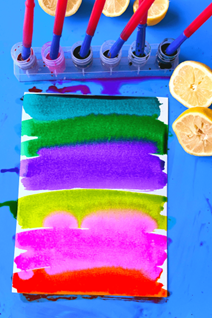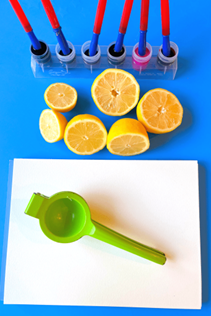Lemon and Watercolor Science


Science


· Liquid watercolors (or pan watercolors)
· Thick paper (watercolor paper or cardstock)
· Lemons
· Thick paintbrushes
· Lemon juicer (optional for extra fun)

1. Prepare the Paper: Use thick paintbrushes to saturate the paper with watercolors. Ensure the paper is fully wet and colorful. You can paint stripes or patterns using a variety of colors.
2. Add Lemon Juice: Squeeze lemon juice directly onto the wet watercolors.
3. Observe the immediate reaction: Lemon juice has citric acid which interacts with the watercolors, causing a bleaching effect. Watch as colors change, mix, blend, and transform right before your eyes.
4. Observations: Discuss with children the changes they observe: Predict what will happen when lemon juice touches different colors.
5. Explore why lemon juice affects the colors differently, especially noting the reaction with orange paint turning red. Encourage sensory exploration of lemons: how they look, feel, smell, and taste.
6. Learning Outcomes:
Science: Understanding chemical reactions (citric acid and watercolors).
Art: Exploring color blending and transformation.
Sensory: Engaging multiple senses through smell, touch, and visual observation.
7. Conclusion: Lemon and Watercolor Science is a delightful activity that combines art and science, perfect for exploring color reactions and sensory experiences with children of all ages.



